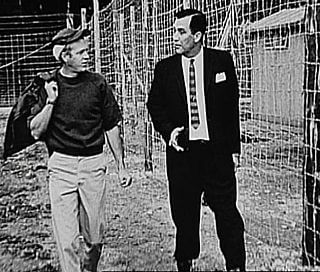
Steve McQueen (left) with Wally Floody, who was a technical advisor in production of the 1963 film The Great Escape. [Wikimedia]
Born in Chatham, Ont., in 1918, Floody enlisted in the RCAF at the outset of the Second World War and was put on the waiting list for the British Commonwealth Air Training Plan. After some persuading—since the RCAF was looking for single men and Floody was married—he was ordered to report to No. 2 Manning Depot in Brandon, Man., on Thanksgiving weekend 1940.
He graduated from pilot training in May 1941, and by the end of the month was in England flying Spitfires as part of 410 Squadron, RCAF.
In late-October 1941, a German Me. 109 fighter shot him down over France and he was captured. He was initially sent to the Stulag I prisoner-of-war camp, which he tried to escape from twice, before he was sent to Stalag Luft III. Dead set on breaking free, Floody designed and helped dig three escape tunnels, which were code-named Tom, Dick and Harry.
Floody was almost buried alive twice during the construction of the tunnels, which once completed lay some 10 metres underground and extended more than 100 metres. Creating compasses out of melted-down razor blades and music records and forging travel and identity papers, Floody and other PoWs readied for their breakout.
However, when one of the tunnels was discovered, Floody, in what likely saved his life, was sent to another camp. Still, one tunnel remained secret and, on the night of March 24, 1944, 200 airmen attempted to hightail it; 76 made it out before the tunnel was found by guards.
Floody was set free after the Soviet Red Army liberated the facility in April 1945.
Advertisement





















